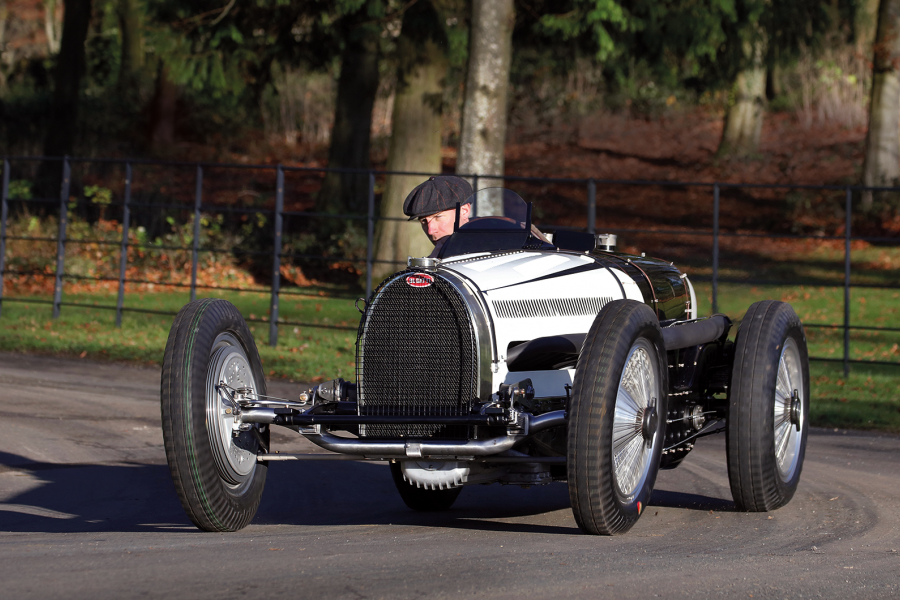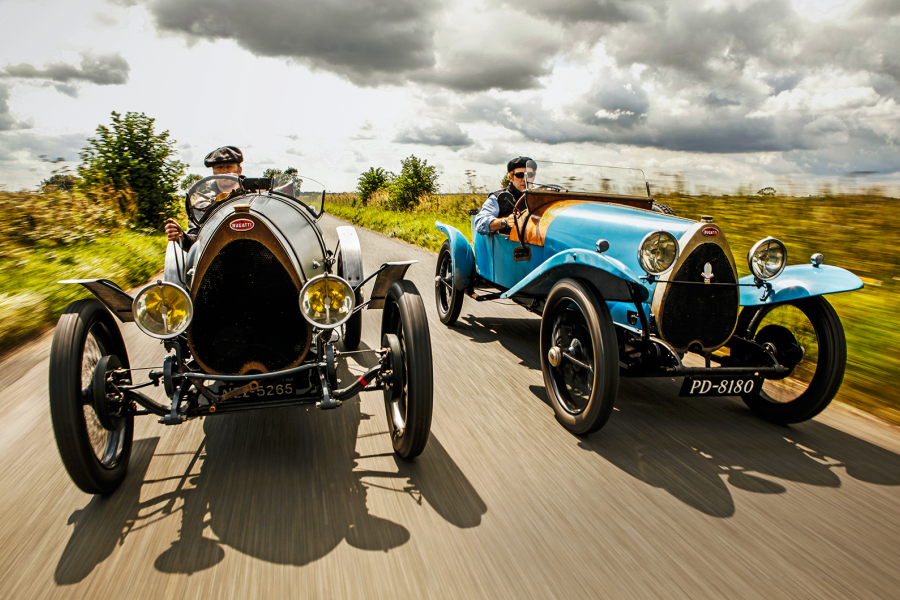But the split windscreen post, which is prone to cracking the paint and often adjusted on concours cars, was kept just as Molsheim’s craftsmen had fabricated it.
Robert Dean, a former boat builder, was entrusted with the woodwork.
Several of Howe’s cosmetic body tweaks have been changed, but only where it was felt that such details spoilt the elegant flowing lines.
The Bugatti Type 57S Atalante is superbly poised
Hefty one-piece chromed bumpers had been fitted early in Howe’s ownership, but Fabri decided to put these aside and remake Bugatti’s more attractive two-piece front type.
The rear was left exposed like many of the 17 Type 57S Atalantes had been finished.
Howe’s distinctive chrome boot rack and twin spotlights were all retained, however.
Opening the bootlid latches proved fiddly with the rack fitted, causing rapped knuckles, until one of Dutton’s team found an old railway carriage key that does the job perfectly.
The semaphore indicators fitted into the roof sides were also retained and repaired.
The Bugatti Type 57S Atalante’s luggage rack survived the restoration
As with the bodywork, the chassis was stripped down for a thorough check and overhaul.
New crank, pistons and Carrillo rods were fitted while it was further refined with a fluid-filled damper to the front.
“The original design was fine until it got wet, but this makes a big difference,” says Dutton. “The engine gives about 200bhp, with really impressive mid-range torque.”
As with many customers’ Bugattis that are regularly driven, Dutton fitted an overdrive to the Atalante: “It was pretty low geared, which suited pre-war roads, but you now get the best of both worlds.
“It knocks a third off when cruising, with 70mph at only 2500rpm.”
The switch is cleverly disguised inside the centre console.
The Bugatti Type 57S Atalante’s doorcard design was confirmed as bespoke to Earl Howe in a period photo
The chassis rebuild included sorting the broken back axle, which was one of the reasons why previous owner Carr took the Atalante off the road, while the complex De Ram dampers were meticulously rebuilt.
Each unit has more than 300 parts.
Once the body was refitted and the colour agreed, the Atalante went to Bicester Bodyshop for a cellulose respray.
To complete the final appearance – and for safer driving – a set of chromed Borrani wire wheels was ordered that authentically matched Howe’s preferred design.
“Hubert is the perfect customer who trusts our judgment,” says Dutton. “He doesn’t try to micro-manage, but is totally passionate about the project.”
Removing the Bugatti Type 57S Atalante’s back bumper revealed the car’s elegant curves
“Like us, he’s not interested in faking patina and, if the car is regularly driven, it soon settles and looks real,” he continues. “The ‘discovered’ condition wouldn’t do justice to this work of art, and wouldn’t reflect Howe’s personality.
“We wanted a finished Bugatti that the owner would choose over a modern Audi A8 for a run to the south of France simply because he loved driving it.”
Dutton tried to get Howe’s original registration ‘DYK 5’ for the final touch.
After tracing it to a modern Bentley, contact was made with the keeper via the DVLA but he wasn’t interested in selling.
Fabri then decided on a period-style ‘OT 3’, which was elegantly hand-painted.
The Bugatti Type 57S Atalante’s chrome steering column is wrapped in leather to stop reflections in the windscreen
The Atalante was restored not to become another precious Bugatti concours queen.
When work started, the milometer read just 26,000, which Dutton reckons was correct, and it has clocked up thousands more since: “Howe bought the car to drive and felt that it was fast enough without the added complication of the supercharger.
“Everyone wants the SC spec now, but too many have become exclusive toys that rarely get used.
“Even unsupercharged, the Atalante has comparable performance to a Jaguar XK120 and, in 1936, a Type 57S was one of the fastest cars on British roads.”
Inside, the Bugatti Type 57S Atalante’s removable cluster gives access to the magneto
Dutton has taken 57502 back and forth to Switzerland four times for the owner, preferring to drive to Geneva rather than transport this valuable car.
“It’ll cruise happily at 80mph at relaxed revs with the overdrive,” he enthuses. “I’ve had it up to 120mph just to see what it was like.
“The chassis runs perfectly straight and stable. The performance is really good, but the brakes are the only limiting factor.
“It just won’t stand on its nose if a truck suddenly pulls out, and that’s always at the back of your mind.
“For me, it’s the finest road car of the era, and the Alfa Romeo 2.9 – with its poor gearbox and horrible suspension design – is no match.”
This Bugatti Type 57S Atalante combines its previous owners’ personal touches
“The Type 57S really should have been called a Type 59 Sports because it’s much closer in detail,” he adds. “The gearbox is lovely and the live rear axle works beautifully.”
The fact that this glorious machine is still used exactly how Jean and Ettore conceived it is encouraging news in an age of unbelievable values.
Just imagine motoring along a route nationale in the autumn, and suddenly this sleek blue-black beauty appears in the rear-view mirror.
Just to see it and hear it roar past would be as magical as being behind the wheel.
Images: Tony Baker
This was first in our November 2016 magazine; all information was correct at the date of original publication, however time-sensitive information and references to dates in the past were updated when this story was uploaded to the Classic & Sports Car website in October 2024
Enjoy more of the world’s best classic car content every month when you subscribe to C&SC – get our latest deals here
READ MORE
Bugatti Type 57S: Molsheim’s missing link
Elisabeth Junek: the pioneering Miss Bugatti
Bugatti Type 57 Stelvio: a peak in the range
Mick Walsh
Mick Walsh is Classic & Sports Car’s International Editor


























